Are you looking for a stylish way to display your kitchenware? Perhaps you’re a collector, and the antique hutch niche has piqued your interest, as they’re becoming increasingly popular and selling well at antique markets. Knowing what to expect in terms of values and styles will help you in your search.
Antique hutches are elegant and traditional, and they complement almost any home style. Due to the smaller size of modern apartments, these items may be uncommon in homes. They can, however, be used in storage units or attics.
If you’re considering starting an antique hutch collection or selling one, this article will explain how to identify these antique hutches and what to look for before buying or selling an old piece.
Table of Contents
History of Antique Hutches
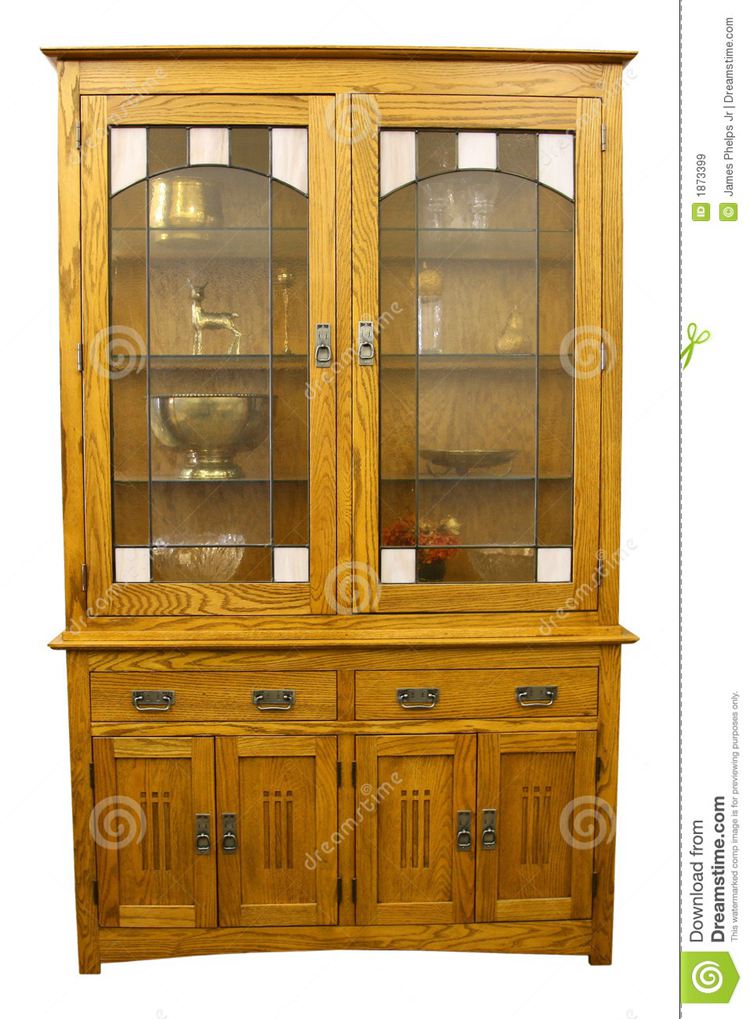
Contrary to popular belief, antique hutches do not originate from China. It is a common misconception because owners commonly use it to house and display Chinese tableware, also known as fine china.
Antique hutches were first built in the 17th century in England, but their popularity grew in the 18th century. Its fame quickly spread throughout Europe, particularly in England and the Netherlands. Soon after, the United States joined the trend.
Many American states, including New York, Philadelphia, and Virginia, even went on to create their own unique styles.
The hutch’s fame spread across the United States easily because large lunch or dinner gatherings for celebrations were commonplace back then, making the hutch valuable as it stored all necessary dinnerware.
If you walked into people’s homes back then, you would most likely see an antique China hutch proudly displayed in the hallways. Homeowners most likely did this as a sign of status and to add some style to their homes.
Owning a hutch was associated with wealth. Because of this, middle-class individuals used ownership of one to elevate their social status, especially since they did not always have the financial capacity to invest in Chinaware as it was more expensive.
Antique Hutch Styles
The term “hutch” is typically used in the United States to refer to a piece of furniture that has multiple shelves resting on top of a lower counter.
There are many different styles, sizes, and shapes of antique hutches. Some hutches are designed for display, while others are kept hidden to protect the items they contain. The type of antique hutch you choose will depend on the available space, as some are wider than others.
Although there are numerous styles, the majority of which are determined by the individual creativity of manufacturers, they can all be divided into three major categories.
The antique hutch style is based on function, style based on manufacturers, and style based on the production era.
Antique Hutch Styles Based on Function
Depending on the style and design, different types of hutches are used for specific purposes.
❖ Antique Buffet Hutch
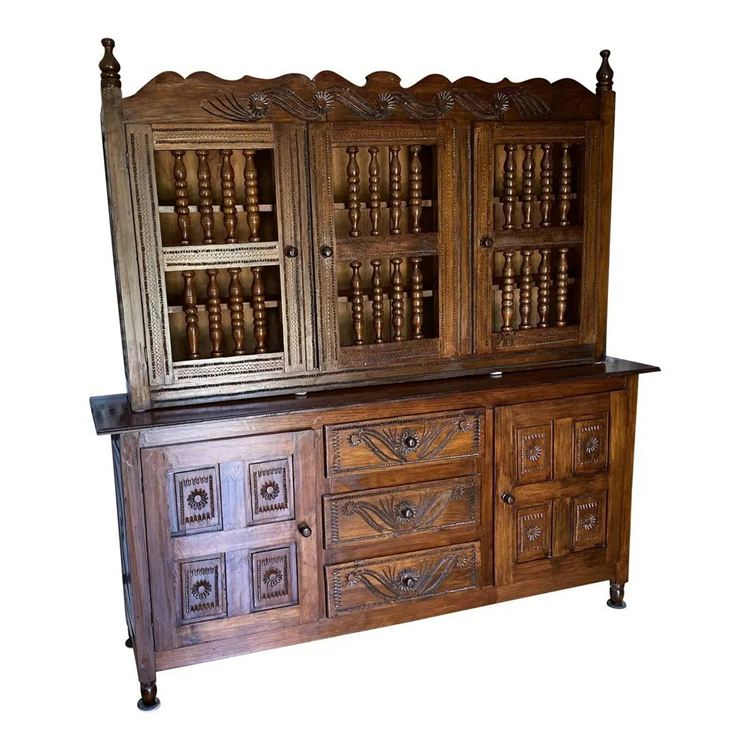
The Buffet Hutch, also known as the Jacobite Hutch, is the most basic style of the antique hutch and was most popular in the 1970s. This model is a simple, large buffet hutch with hand-crafted details.
Details like these are typical of the Mexican folk art decoration style. Some models have wheels, making it easier to move around and allowing it to be used beyond the dining room, thereby making this piece not only beautiful but also functional.
The slab surface of this buffet hutch is complemented by cabinet drawers and shelves. This piece was designed by woodworkers with the primary goal of providing additional storage and space for kitchen finery.
It may be made entirely of wood or of wood with glass panels. This hutch is available for $4,012 on Liveauctioneers.
❖ Antique Kitchen Hutch
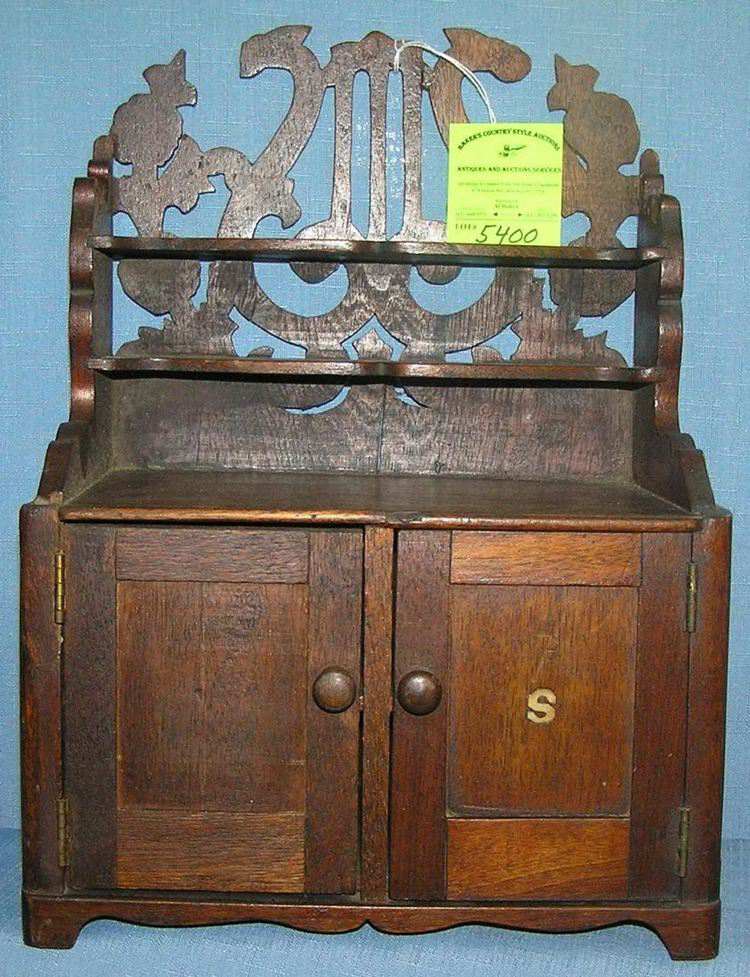
The kitchen hutch is a great storage space that doubles as a workspace thanks to its multiple shelves and cabinet base. It is also commonly referred to as a Hoosier cabinet. The kitchen hutch was a popular choice for storing items in the late 19th century.
Materials used to craft this design of hutch range from cherry, poplar, or pine, depending on the specific era. However, pine was the most popular wood type used for the construction of the hutch in the 1800s.
Unlike the buffet hutch, there are no models with wheels for the kitchen hutch because it was barely used anywhere other than the kitchen. Due to their size, manufacturers ensured that their leg stands were durable enough to remain upright for an extended period.
This style of the antique hutch is currently popular among homeowners and interior decorators because of its spaciousness and versatility. Owners can keep decorations, artwork, and books on its wide flat top. It is available for $225 on LiveAuctioneers.
Antique Hutch Styles Based on Manufacturers
Popular manufacturers of antique hutches include Sheraton, Chippendale, and Hepplewhite, commonly referred to as the “Big Three” of English furniture style. We will discuss the styles of the hutch in this section.
❖ The Sheraton Hutch Style (1790-1820)
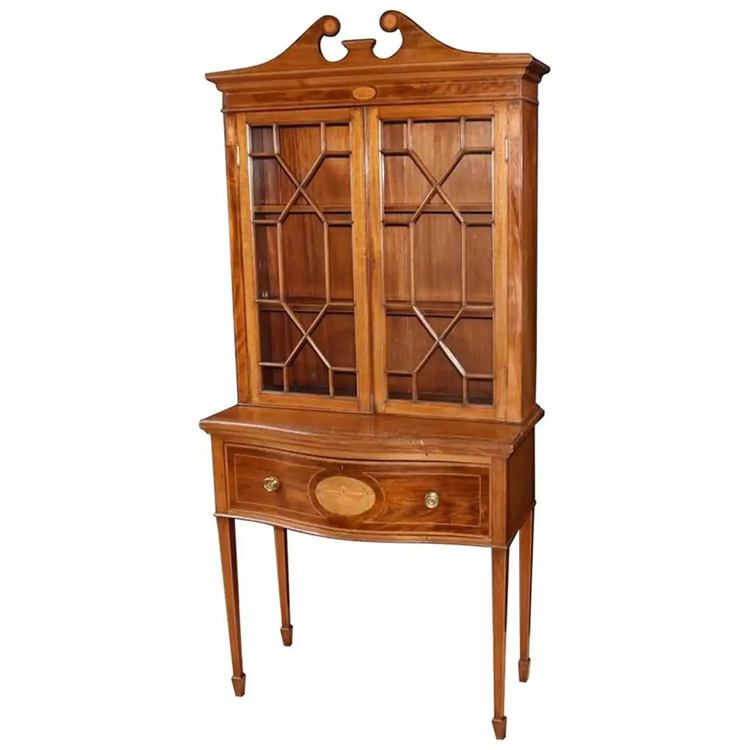
Thomas Sheraton was a popular English furniture designer in the 18th century. Although these styles were more popular in America and included as part of the federal style.
Many of his designs feature the use of exotic woods like mahogany, beechwood, ash, rosewood, and birch for decorative elements. Sheraton pieces usually have three distinguishing features.
- It’s light, elegant appearance makes it appear more delicate than other manufacturers of the same era.
- It has straight long legs.
- The presence of open shelves, which are usually large enough to serve as storage units.
His piece designs are refined, strong, and well-proportioned geometric shapes, usually square or rectangular, often including secret drawers and mechanisms for sliding sections.
❖ The Chippendale Hutch Style
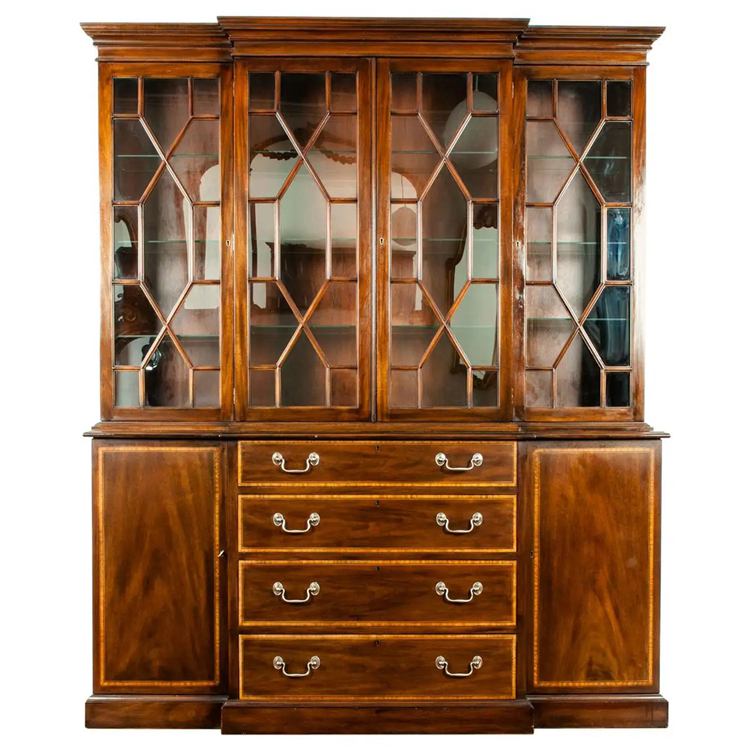
Chippendale rose to prominence in the 17th century for his practical, functional, and aesthetically pleasing designs, which he was able to accomplish through his understanding of the relationship between design and craftsmanship.
The wood carving on this hutch is its defining feature. His designs had different themes, including:
- The exotic latticed and lacquered Chippendale style which was influenced by trade with Eastern countries.
- The elaborate French Rocco Chippendale style, influenced by the elaborate styles of the French.
- The GothicChippendale style with pointed arches as a reflection of the English cathedral buildings of his time.
He is also popular for incorporating large, bold brass hardware into his hutch and furniture pieces.
❖ The Hepplewhite Hutch Style
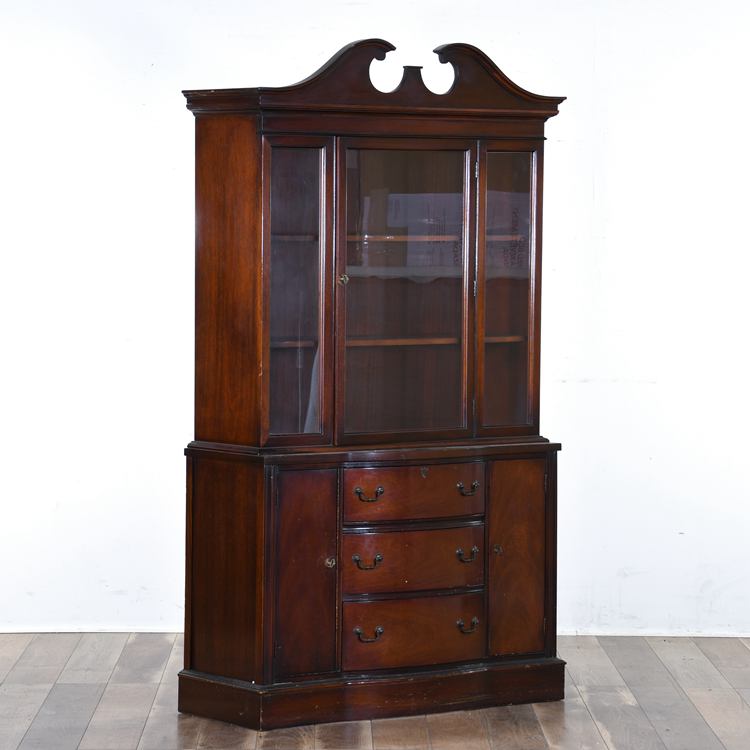
Hepplewhite furniture dates from 1780 to 1810. His designs are simple and reflect the neoclassical style, mostly influenced by Ancient Greek artifacts and architecture.
Hepplewhite’s designs are known to be light and well-balanced. This, along with the carvings on the flat surface of the doors, makes it easy to recognize his style. There may also be two or more doors on each side, as well as an open glass panel for displaying fine china.
Unfortunately, he passed on in 1786, leaving his wife to run the business. In 1788, she published a book titled “The Cabinet Maker and Upholstery Guide.” His style and reputation were written in this guide, which is why reproductions are so common.
Antique Hutch Styles Based on Era
The following are classifications of antique hutch styles based on the era they were built:
❖ Early American Style (1720-1790)
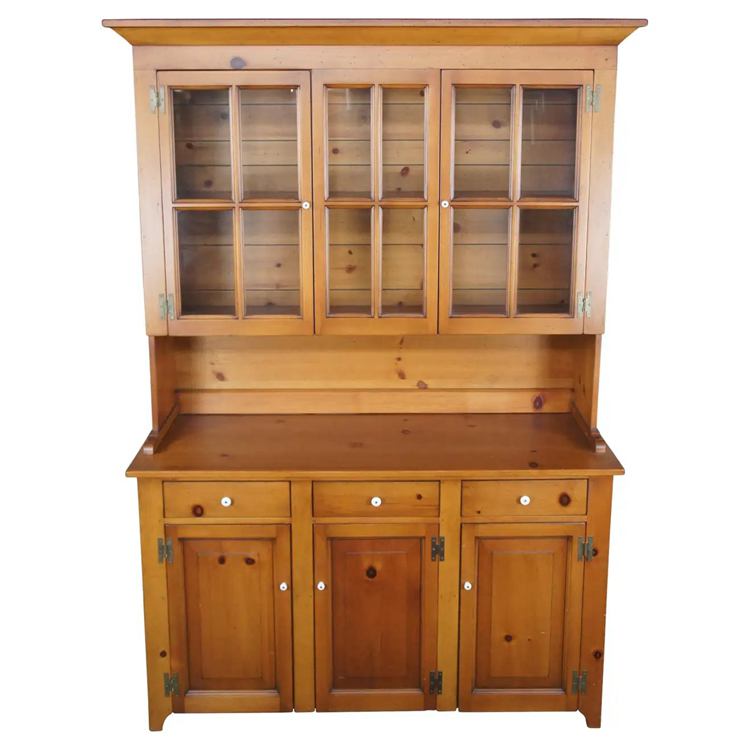
This type of hutch typically features one or two doors, no drawers, and straight legs, though some other versions come with drawers. This lovely display cabinet can be used for both serving and storage.
This hutch’s typical dimensions are 36 inches wide, 19 inches deep, and 72 inches tall. Cherry, pine, oak, and mahogany were commonly used in the woodwork of the early American hutch style.
❖ Biedermeier Style Hutch (1830-1850)
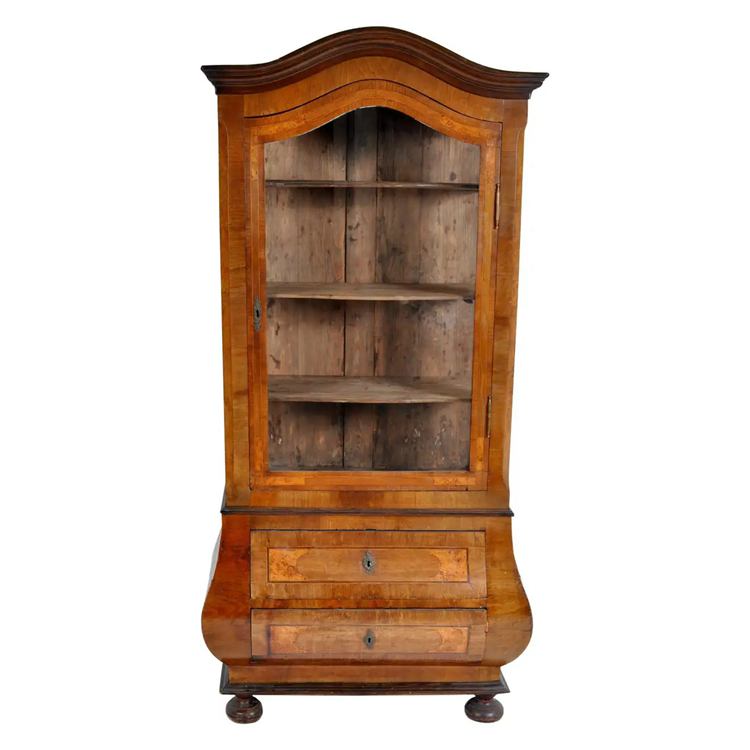
The Biedermeier style hutch is a German-inspired style hutch that emerged between 1830 and 1850.
These pieces are distinguished by two key features, the presence of high bases raises the piece to four hips and short or compressed bun feet. Also common are designs carved into doors, as well as reliefs that produce a 3D effect.
Queen Anne (1660-1690)
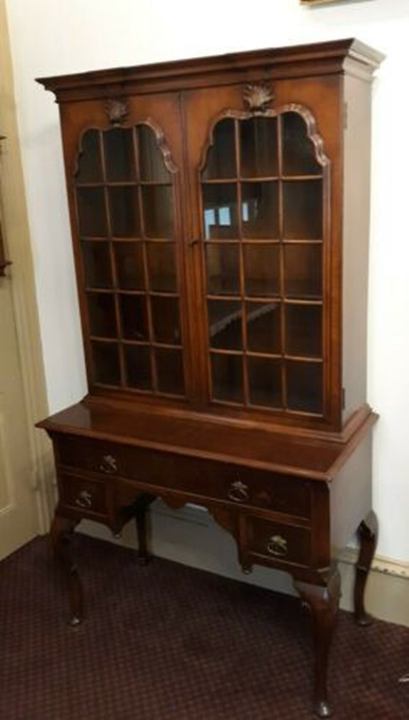
This style was named after the popular monarch queen Anne during her reign (1702-1714). It quickly gained popularity in England and the United States.
This style frequently features floral patterns on each door and claw foot. The Queen Anne style is easily identified by the doors having brass or white handles in the shape of an S, or U. Queen Anne furniture is typically crafted from mahogany, walnut, and cherry.
Some other popular era styles include;
- Mid victorian style (1850-1870)
- Italianate style (1840-1880 )
- Georgian style (1710-1785)
Identifying an Antique Hutch
Even for professionals, identifying antique hutch pieces can be difficult. However, some indicators can assist in determining whether their antique hutch is valuable.
Imperfect Matching of Elements
Because antique hutches were mostly handcrafted back then. It’s natural for small matching elements like drawer knobs to differ slightly. Machine-made hutches will have more perfect elements, as machines are the only way to produce exact furniture components repeatedly.
Wood and Mirror Glass Orientation
The mirror glass of an antique hutch should have visible signs of deterioration. Damage to the wood and classic lead mirrors is common, which is understandable given how long these hutches have been around.
Due to the lack of modern technology, wood joints may have marking defects and other flaws.
Coatings Applied to the Antique Hutch
To protect the body of wood from damage such as wood rot, old oil varnishes were applied to antique hutches. Old woodworkers used anti-rot varnish regularly. Because of the varnish, these antique hutches may have a strong odor and a dull appearance.
Antique Hutch Value
This antique furniture is valuable because it is large, intricately crafted, and durable enough to last for many years. The value of antique hutches rises if they are still in good condition or are authentic to a specific era or style.
Finding an original antique hutch for less than $5,000 to $10,000 can be difficult. The prices are justified because they will last you a lifetime.
Antique Hutch Prices Guide
Now that you understand how to identify antique hutches and their value, the table below provides examples of hutches available online to give you a better idea of what to expect.
Antique hutch |
Prices |
$5,395 |
|
$5,350 |
|
$3,196 |
|
$4,400 |
|
$2.200 |
|
$4,012 |
|
$2,550 |
Other Ways to Use an Antique Hutch
Although wood used to build hutches can last for many years, there is still a risk of wood rot and deterioration. Restoration and repair will require professional assistance.
It’s important to get the help of experts who can help you make your antique furniture more functional without compromising its historical value before you begin restoration.
The great thing about these timeless pieces is that you are not limited to the traditional way of using them. Over time, several ways to repurpose your hutch in a modern setting have been developed by creative and interior decor enthusiasts. Some of these include;
Show Glass Hutch:
You can repurpose your shelves to create your own show glass, which you can use to display trophies, medals, and other items of your choice.
Bar Hutch:
Repurposing into a bar is a great way for wine lovers to express their creativity. You can fit as many bottles of wine and glasses as you want into an antique hutch, as it features a lot of storage space.
Storage Hutch:
An antique hutch will serve as a suitable storage unit. Hutches are large enough to hold all of your kitchenware, as well as seasonal items and clothing.
Album Hutch:
A family photo display booth is also a great idea. Fill the shelves of your antique hutch with photographs of loved ones.
Where to Buy and Sell an Antique Hutch
Due to the ever-increasing demand for antique hutches, as a potential buyer, you will undoubtedly want to get your money’s worth. The following are reputable sites that sell quality pieces of this furniture at reasonable prices.
eBay
eBay is one of the most popular online marketplaces for buying and selling through a third party. It’s also an auction site, so the prices listed on items are usually just starting points for bargaining.
Invaluable
This is another trustworthy site for buying and selling antique hutches. Use the search bar to enter the specifications of the antique hutch you wish to buy.
LiveAuctioneers
If you enjoy the thrill of being the lucky highest bidder, this site is perfect for you. It even has a search feature for specific auction houses.
Frequently asked questions
How Can I Tell if My Antique Hutch is a Replica?
A reproduced hutch will likely have the same type of wood from the top shelves to the cabinets. In contrast, an original piece is made from different types of wood in areas. Also, look for straight saw marks, this indicates an older piece.
What are the Parts of a Hutch Called?
The buffet is the part of a hutch that is enclosed with doors for storage. The top section is known as the display cabinet, and it is often built with glass doors and interior lighting for the proper display of decorative items and fine china.
What is the Difference between a Hutch and a China Cabinet?
A china cabinet is a single piece of furniture with glass doors to show off fine china. A hutch, on the other hand, is made up of two pieces: a buffet and a display cabinet. China cabinets are also more formal than hutches and are traditionally found in a dining room.
Final Words
This antique furniture is worth your money if you are considering adding it to your collection. This traditional piece can also be a beautiful addition to the aesthetics of your home, even if you have a modern home design style. If you have any questions, please leave them in the comment section.





![Where To Sell Antique Furniture In 2022 [Ultimate Guide]](https://www.jacquelinestallone.com/wp-content/uploads/2022/09/Etsy-Your-Place-To-Buy-And-Sell-All-Things-Handmade-600x450.jpg)


